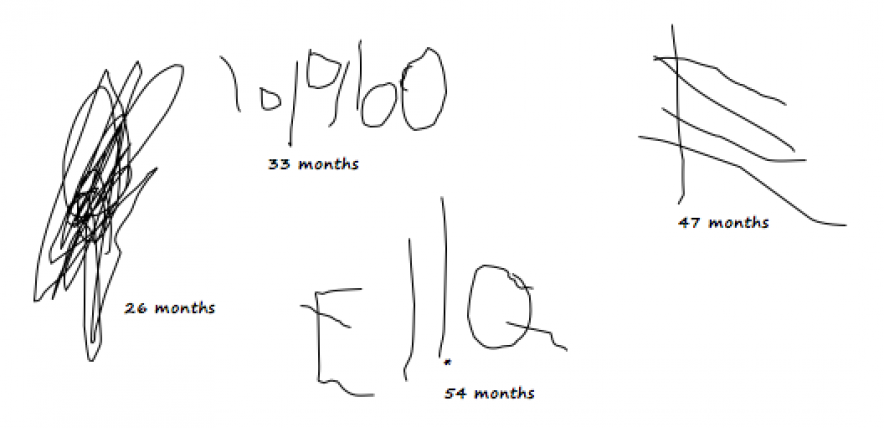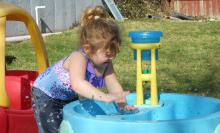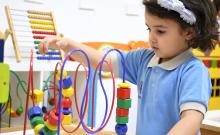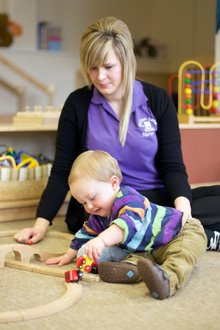By Nicky Sanford
What is mark making and why is it important?
Children begin their journey towards writing, not by producing letters and words, but by simply making marks.
Mark making is the first step towards writing.
Often one of the first signs that children are interested in the marks they can create comes when your litte one begins to play with spilt food or drinks, using their palms and fingers to create patterns and swirls.
Mark making is part of physical development
As muscles and control develops, children progress to using crayons, pencils or chalks to make big circular and straight lines. This type of mark making is often dismissed as scribble, but is actually an important step in learning to write and the skills that emerge with practice.
For young children, learning to control any mark making tool, such as a pencil, pen or paintbrush, is hard and requires many skills.
They need to develop whole body muscles (gross motor), to control their upper body and shoulders as well as develop the desire to sit still and concentrate.
Many of these initial skills can be supported by play thorugh being active and being outstide. Hand-eye coordination is also key for writing as is the need for children to build up the control in their hands and fingers (fine motor skills).
Searching for meaning
The marks children begin to make slowly start to have more meaning for them and at first may seem like random swirls but soon you may see the emergence of circles, lines and dots.
As your child watches others around them writing they begin to realise that the marks you make actually mean something and so will want to recreate that sense of meaning by ‘pretending’ their marks represent something.
By listening to their conversations as they mark-make, you may hear them talk about what their ‘writing’ says.
Most often, it is a child’s own name which they are keen to be able to prodcue, this gives them a great sense of identity and pride particularly when they can sign off a birthday card, or name their own drawings. It obviously boosts parents' pride too when you see the first emergence of a recognisable letter with this mark-making and you know that this was your child.
A helping hand
First of all, it is helpful to remember that learning to write takes a few years!
Patience and support are needed over that time.
Children who are corrected too often, or asked to write things out ‘properly’ may lose all interst. On the other hand, children who enjoy the process of mark making and ‘writing’ notes that are praised and valued will naturally want to do it more often, and so get better at it.
How to encourage mark making
Start by providing lots of different types of writing tool, crayons, felt tips, pencils, chalks, and – if you can bear it – paint!
Don’t worry about buying paper, your child will be happy using the back of junk mail, scrap paper or leftover wallpaper rolls or even the pavement.
Once your child has begun to show an interest in writing and begins to acquire the necessary skills, there are other ways in which you can support them in development these even further.
For example, show them how.
Let children watch as you write for a variety of reasons.
Model writing by using capital and lower case letters in the correct context, for example James rather than JAMES.
Add their name to any pictures or artwork, starting in the upper left hand corder, to reflect that reading/writing in English is from left to right.
Sequencing games and puzzles can help support left – right coordination.
Get them physically ready to write
It's important that children are physically ready to begin writing.
Start big and exercise their shoulder and arm muscles.
Some great ideas are: pulling on arms when climbing, twirling ribbons in the wind, sweeping with a garden brooms, filling and emptying wheelbarrows, drawing giant chalk circles, ‘painting’ with water, and in fact anything that gets your chilid stretching up or across their body!
Then working the fingers are essential for comfortable writing and there are lots of games and activities which are idea for developing these muscles — for example, threading and sewing games, fusible beads, Play-doh, tweezer games, posting and stacking games. However, there are just as many things that can be found around the home that will work just as well!
As skills develop further, please note that it is very common for children to write letters/words in reverse, produce letters in random positions on the page... just a gentle reminder is all that is needed to keep them on the right track and maintain their enjoyment.
Many children might also display an ‘unusual’ pencil grip, this too will develop along with their motor skills and is best left to the child to ‘correct’ once they are ready.
Most importantly – have fun!
Let them go at their own pace
Some children display the necessary motor skills for writing at around 4 years of age and your early years setting should support and develop these skills through a variety of literacy opportunities.
But bear in mind that all children develop different skills at different times so equally your setting should be encouraging each child’s individuality and support their interests and abilities.
At the pre-school age the main aim is for children to gain a sense of enjoyment at colouring, drawing and mark-making.
They are then well on the road to developing the skills required for writing actual letters some time before the end of their Foundation year and allowed to do so at a pace which enriches their experiences along the way.
Written by Nicky Sanford for the Alliance. Nicky has worked as an early years teacher for 15 years and currently works in a village pre-school.







